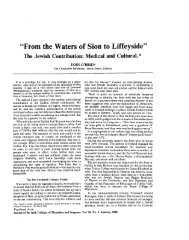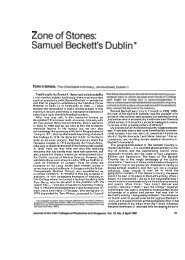second-intl-consenus-meeting-on-24-hr-abpm - Eoin O'Brien
second-intl-consenus-meeting-on-24-hr-abpm - Eoin O'Brien
second-intl-consenus-meeting-on-24-hr-abpm - Eoin O'Brien
You also want an ePaper? Increase the reach of your titles
YUMPU automatically turns print PDFs into web optimized ePapers that Google loves.
S4 Journal of Hypertensi<strong>on</strong> 1991, Vol 9 (suppl 8)<br />
than <strong>on</strong>e occasi<strong>on</strong> during a dosing interval [16]. The<br />
day cannot be far off when ambulatory blood pressure<br />
m<strong>on</strong>itoring will beco~ne a niandatory - recluiretnent<br />
-<br />
for new drug a~~plicati<strong>on</strong>s in tlle European Community<br />
I171.<br />
Definiti<strong>on</strong> of 'normal' <strong>24</strong>-h ambulatory<br />
pressures<br />
C<strong>on</strong>siderable effort is being expended to define tlie<br />
range of ambulatory blood pressure in normal subjects<br />
118-291. 'firee approaches, each based solely<br />
<strong>on</strong> blood pressure, are curretitly being used. l'he first<br />
takes the 95th centile (or 2 standard deviati<strong>on</strong>s) as the<br />
upl,er liniit of blotxl pressure for a nor~nal populatiotl.<br />
The problem here is that the 95th centile of a truly<br />
~o~>i~iatiot~-basedsd sample is likely to Ile much Iligher<br />
tl~an any accel,ral,le cutolf point, because tlle prevalence<br />
of hypertensioli ill the pc,l,ukati<strong>on</strong> is Inore thau<br />
5%. 'l'herefore, it is necessary to exclude tlle 'hyperte~lsives'.<br />
This, however, has to be d<strong>on</strong>e <strong>on</strong> the basis<br />
of clinic blotxl pressures, so tlie definiti<strong>on</strong> of nor~nal<br />
dues will be largely detertnined by the criteria used<br />
for defining hypertensi<strong>on</strong>, and this knits he validity of<br />
the method.<br />
A <str<strong>on</strong>g>sec<strong>on</strong>d</str<strong>on</strong>g> method is to establish the level of ambulatory<br />
blood pressure that is equivalent to a particular<br />
clinic blood pressure level, such as 140/190mmHg<br />
[22]. The regressi<strong>on</strong> line relating clinic and ambulatory<br />
1,ltwl pressures for a populati<strong>on</strong> of norniotensives<br />
and hypertensives can be used to define this, but the<br />
j~rcxedure is diliicult; altlloi~gl~ the mean atnbulatory<br />
blood pressure correspotiditig to a given clinic pressure<br />
cat1 be easily predicted, the error in predicting<br />
the atnl~ulatory blood pressure in individual patients<br />
is much too large for clinical pulposes. This method<br />
has tlie advantage of being independent of any prior<br />
definiti<strong>on</strong> of hypertensi<strong>on</strong> in selecting the reference<br />
populati<strong>on</strong>, but is still based <strong>on</strong> an arbitrary reference<br />
point, the clinic pressure.<br />
A third mehod uses the c<strong>on</strong>cept of blood pressure<br />
loacl, which is defined as the percentage of readings<br />
above a certain level [30]. This approach is faced with<br />
the same selecti<strong>on</strong> problems as in the first method and<br />
is even more unsatisfactory, as it depends <strong>on</strong> an arbi-<br />
trary t<strong>hr</strong>esllold level.<br />
At1 alternative approach to the t<strong>hr</strong>ee methods de-<br />
scribed is to relate blood pressure to cardiovascular<br />
risk, either directly as cardiovascular morbidity, or in-<br />
directly by relating blood pressure to an index of tar-<br />
get organ datllage, sucll as left ventricular hypertrophy<br />
(311. In either case, the relati<strong>on</strong>ship between blood<br />
pressure and risk is likely to be steeper for atnbulatory<br />
than for clinic blood pressure. Although theoretically<br />
preferable to methods that rely solely <strong>on</strong> blood pres-<br />
sure, these methods are much more expensive to carry<br />
out and it will be many years before data are avail-<br />
able. A further drawback is the fact that the relati<strong>on</strong>-<br />
ship between ambulatory blood pressure and the inci-<br />
dence of cardiovascular complicati<strong>on</strong>s is c<strong>on</strong>tinuous.<br />
Indeed, there is no t<strong>hr</strong>eshold above which the risk sud-<br />
denly increases, and the decisi<strong>on</strong> about what level of<br />
risk is acceptable must be an arbitrary <strong>on</strong>e. Neverthe-<br />
less, such methods provide the <strong>on</strong>ly way of deterrnin-<br />
ing those levels of ambulatory blood pressure that are<br />
truly healthy, and at least two l<strong>on</strong>gitudinal studies are<br />
now underway [32-341.<br />
While awaitil ~g the outcome of these studies, and given<br />
the rapid applicati<strong>on</strong> of ambulatory blood pressure<br />
m<strong>on</strong>itoring in clinical practice, it is important to have<br />
a working definiti<strong>on</strong> of n<strong>on</strong>nal values whicli will be<br />
dependent <strong>on</strong> data derived from studies of clinically<br />
determined normotensive populati<strong>on</strong>s. There are now<br />
a large nutilber of these studies in different popula-<br />
ti<strong>on</strong>s [ 18-29] and it is hoped that a meta-analysis may<br />
provide tlle infunnati<strong>on</strong> required for defining more<br />
precise age- and sex-specilic diagnostic criteria. Thus,<br />
guidelines may be obtained for the applicati<strong>on</strong> of nor-<br />
mal values in tlie clinical use of ambulatory blood pres-<br />
sure m<strong>on</strong>itoring [35].<br />
Clinical applicati<strong>on</strong><br />
The most important clinical applicati<strong>on</strong> of ambulatory<br />
blood pressure m<strong>on</strong>itoring is the evaluati<strong>on</strong> of patients<br />
with borderline hypertensi<strong>on</strong>, in whotn the decisi<strong>on</strong> to<br />
start treaunent rests <strong>on</strong> an accurate assessment of true<br />
blocxl pressure [13]. If it is accepted that patients with<br />
nortnal atnbuhtory blood pressures but raised clinic<br />
blood pressure (white-coat hypertensi<strong>on</strong>) do not need<br />
treatment, there is a prospect that ambulatory m<strong>on</strong>-<br />
itoring could be very cost-elIective [36]. It has been<br />
estimated, for example, that the number of patients<br />
with mild hypertensi<strong>on</strong> needing antihypertensive treat-<br />
ment can be reciuced by nearly 75% without increas-<br />
ing morbidity [36]. Ambulatory blood pressure m<strong>on</strong>i-<br />
toring nlay also be particularly helpful in selecting the<br />
most ajlpropriate drug and dosing interval for an indi-<br />
vidual patient and in assessing the resp<strong>on</strong>se to treat-<br />
ment [13].<br />
In patients with <str<strong>on</strong>g>sec<strong>on</strong>d</str<strong>on</strong>g>ary hypertensi<strong>on</strong> the procedure<br />
is of limited value, because the altered diurnal pattern<br />
is n<strong>on</strong>-specific. Iiowever, the loss of the normal noc-<br />
turnal dipping pattern may alert the clinician to look<br />
for a cause for elevated blood pressure [ 11 1.<br />
Ambulatory blood pressure m<strong>on</strong>itoring also plays a<br />
role in assessing patients with symptoms suggestive of<br />
postural or drug-induced hypotensi<strong>on</strong> [13,37].<br />
A major questi<strong>on</strong> awaiting attenti<strong>on</strong> is the recogniti<strong>on</strong><br />
of the procedure by reimbursing agencies. In most<br />
countries ambulatory blood pressure m<strong>on</strong>itoring is









